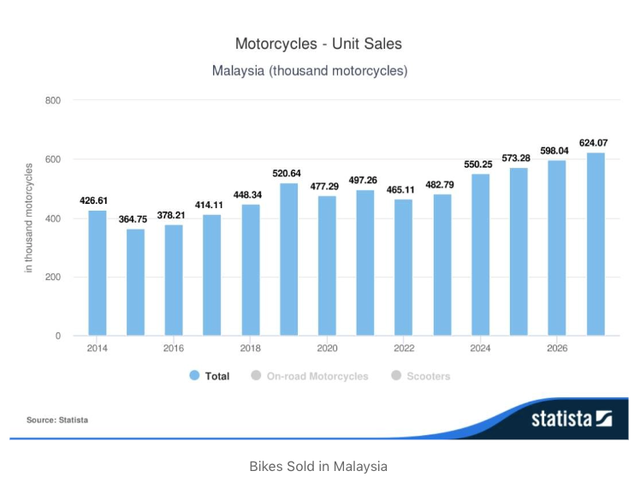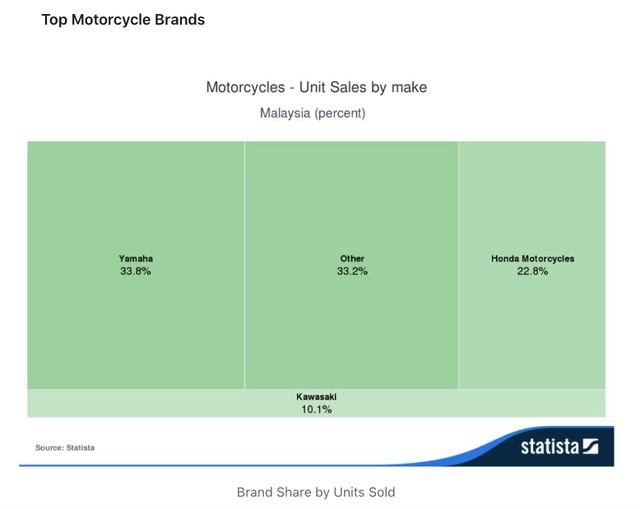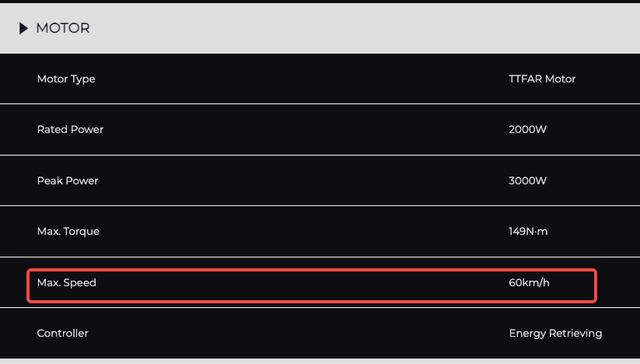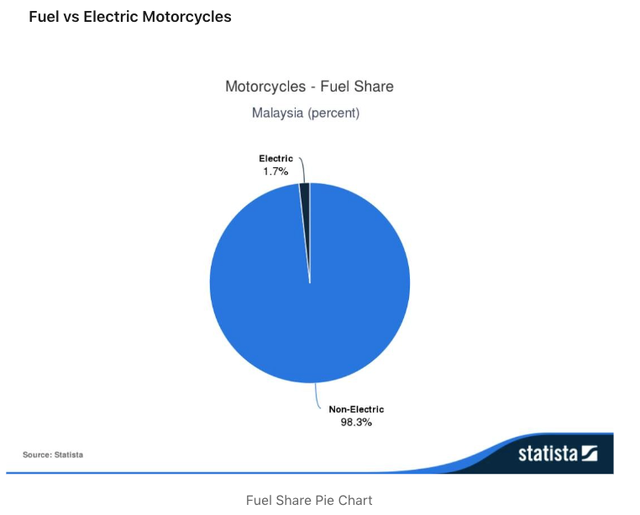Source: Xiaguang Society By Yang Zi
Walking on the streets of Kuala Lumpur, the capital of southeastern Asia's Malaysia, you can immediately feel the "speed and passion" of this region: Whether on the main roads, highways, or small alleys, you can see all kinds of motorcycles everywhere—riders wearing helmets, traveling at high speeds, often overtaking cars with a roar.
This "speed and passion" was mostly felt on the highway from Kuala Lumpur Airport to the city center. Many motorcycles weave through the flow of cars, and most of them travel faster than the cars.
Fast speed and large numbers make even a simple daily commute feel like an adrenaline-pumping roller coaster ride.
In Malaysia, motorcycles are the most common means of transportation. With a population of about 34 million, Malaysia has about 10 million motorcycles, meaning that one in three people owns a motorcycle.
On one hand, due to Malaysia's late start in industrialization and low level of urban infrastructure, motorcycles, with their convenience and speed, can meet travel needs more efficiently. On the other hand, since most cars in Malaysia rely on imports, the high purchase tax makes them unaffordable for local consumers. In contrast, motorcycles offer a more affordable and faster option for consumers.
The large population and rigid demand make selling motorcycles in Malaysia an attractive business. Moreover, the rapidly growing trend makes this market even more appealing. According to Statista, the revenue of the Malaysian motorcycle market is expected to reach $2.85 billion this year and increase to $3.75 billion by 2027, with a compound annual growth rate of 7.10%. In today's market environment, this is a cake that should not be missed.

However, interestingly, the motorcycle industry in Malaysia is still dominated by Japanese companies, presenting an oligopolistic market structure. According to Statista data, Yamaha, Honda, and Kawasaki hold 66.7% of the market share, with Yamaha having the highest share at over 30%, followed by Honda at over 20%.

Why, despite the significant rigid demand in the Malaysian motorcycle market over the past 30 years, have only Japanese brands managed to capture it? In fact, in the 1990s, Chinese motorcycle products were also favored by Malaysian consumers, competing with their products and prices. However, due to a lack of long-term brand strategy, they lost this battle.
Currently, a new wave of oil-to-electric transition is unfolding in the Southeast Asian market. In July 2023, Malaysia announced the first phase of the "National Energy Transition Roadmap" (NETR), covering six major energy sectors: energy efficiency, renewable energy, hydrogen energy, biomass energy, green transportation, and carbon capture, utilization, and storage (CCUS). In August, the second phase of NETR was announced, establishing a specific path to achieve net-zero carbon emissions by 2050.
Opportunities exist within variables. Will the shift from oil to electric bring opportunities for Chinese brands? What approach should Chinese brands take to sell electric motorcycles in Malaysia? We will explore this briefly in this article.
1
For Malaysians, motorcycles are more than just motorcycles
Motorcycles running faster than cars is quite common in Malaysia.
A manager of an offline motorcycle store in Malaysia told Xiaguangshe that motorcycles on Malaysian roads usually travel at speeds not less than 110 km/h. Therefore, a series of safety issues often occur in Malaysia. According to data from the Malaysian Institute of Road Safety Research, motorcycles accounted for 63% of all road fatalities in the country in 2020. Part of the reason for the high motorcycle accident rate is reckless driving and weak enforcement of traffic regulations.
Fortunately, in recent years, the government has taken measures to improve motorcycle safety, including mandatory helmet use and the implementation of stricter traffic regulations.
Speed is just one aspect of the demand for motorcycles in Malaysia; they also need to be more stable and cooler.
In a "fast and furious" country, the demand for motorcycles in Malaysia is much higher than in China. This is evident in the fact that many motorcycles available in offline sales channels in Malaysia are not available in China. Whether in terms of models or displacement, Malaysia showcases faster, more stable, and longer endurance motorcycles. An electric motorcycle enthusiast told Xiaguangshe, "These types of products, which look like they belong to motorcycle sports players, can be used as ordinary transportation tools in Malaysia."
Besides practicality, motorcycles also have cultural significance in Malaysia. In Malaysia, motorcycles are often associated with youth culture, symbolizing freedom and independence. These young riders often hold impromptu races in parts of Kuala Lumpur, competing to see who is the fastest and most skilled, sometimes with dozens of bikes racing together.
Although this sport is illegal in Malaysia, many young people remain passionate about it, showing the deep love Malaysians have for motorcycles.
Therefore, the demand for motorcycles in Malaysia is diverse, and it is not an exaggeration to say that motorcycles are integrated into the lives of Malaysians. For cargo transport, daily commuting, and entertainment, Malaysians need motorcycles. Hence, unlike other markets, Malaysian consumers have higher demands for electric motorcycles.
In contrast, current electric motorcycles cannot yet meet the performance needs of Malaysians.
Take the main model YADEA E8S Pro from Yadea in Kuala Lumpur as an example; its maximum speed is only 60 km/h, which can only meet low-speed, short-distance travel needs. Even better electric motorcycles can only reach speeds of 80 km/h. This is still far from the real usage needs of motorcycles in Malaysia.

YADEA E8S Pro model information
It can be said that the slow progress of electrification in Malaysia is inseparable from the fact that electric power cannot bring the "push-back feeling." To achieve the speed and passion that Malaysians need, electric motorcycles still need to work hard.
2
Slow Electrification in Malaysia
At this point, we need to distinguish between two concepts: electric vehicles and the electrification of motorcycles, which are completely different.
The electrification of motorcycles first requires treating the motorcycle as a vehicle, a means of transportation with high consumer stickiness and higher demands on product quality and speed. In contrast, electric vehicles are used as commuting tools in low-speed environments.
The difference in demand leads to different market preferences for the two. In the Chinese market, electric vehicles are used as commuting tools, and a journey of 3-5 kilometers is acceptable. However, in the Malaysian market, which favors high-speed and heavy motorcycles, electric vehicles can only be described as having a price but no market.
Faced with the overall trend of electrification in Southeast Asia, electric vehicle brands can still play a replacement role in countries with mountains, forests, islands, or severe traffic congestion, meeting some of the demand for low-speed electric vehicles. But for the Malaysian market demand, there is almost no overlap between electric vehicles and motorcycles, making them more like a supplementary option for short-distance, low-speed transportation.
Therefore, most Chinese electric vehicle brands that ventured abroad earlier have focused on Indonesia, Vietnam, and other places where the market space is larger and more suitable for early rapid expansion. Due to the picky nature of the Malaysian motorcycle market, the path of motorcycle electrification in Malaysia shows significant differences compared to other Southeast Asian countries.
This also means that electrification in Malaysia may take longer.
This is also reflected in Malaysia's policy of converting oil to electricity: In the 2024 fiscal budget, the Malaysian government announced an electric motorcycle incentive program, allowing the public to enjoy a government subsidy of up to RM2,400 (approximately RMB3,634) when purchasing electric motorcycles to alleviate tax burdens. However, it is worth noting that the prerequisite for receiving the subsidy is that the rider's annual income must be less than RM120,000 (approximately RMB182,000) or their monthly income must be less than RM10,000 (approximately RMB15,000).
In Kuala Lumpur, the median monthly income is RM15,490. This means that the policy is aimed at lower-income groups. Malaysia is already one of the regions with higher consumption capabilities in Southeast Asia. Even if vehicle prices are high, most consumers will choose to purchase through loans or credit payments. According to observations by TMTPost, most motorcycles in Malaysia are priced between RM8,000 and RM40,000, and the price of electric motorcycles is not much different from traditional motorcycles. This means that for those who are highly sensitive to prices, they cannot afford high-end motorcycles on one hand, and on the other hand, lower-priced electric motorcycles cannot meet their travel speed needs.
It's really a dilemma.
Or rather, the introduction of the policy only promotes the entry of low-speed, short-distance electric transportation tools into the commuting field, providing lower-income consumers with a taste of electrification without changing the original mode of transportation. This is just a bottom-up electrification penetration.
Another case worth referencing is the presence of "purple shared scooters" on the streets of Malaysia, a product launched by the shared electric scooter company Beam Mobility. Riding these readily available small scooters makes commuting 5 minutes faster, serving as a supplementary product for short-distance, low-speed travel in Malaysia. According to Beam Mobility data, in 2022, the number of electric scooter rides in Kuala Lumpur will exceed 1.1 million, with more than 200,000 riders, setting a new high and indicating the initial possibility of tasting electrification.
Undoubtedly, electrification in Malaysia is more challenging to promote than in other regions.
Of course, another reason is that gasoline in Malaysia is very cheap. Malaysia is a net exporter of oil and gas, with oil and gas resources mainly distributed in the western nearshore areas of the Malaysian Peninsula, the eastern Sarawak offshore area, and the Sabah offshore area. Therefore, Malaysia is also one of the countries with the cheapest gasoline in Southeast Asia. If you drive in Malaysia, a car with a fuel tank capacity of 40 liters only needs about RM80 to fill up. Therefore, the reduction in energy costs brought about by electrification is relatively less attractive.
From the data, in 2020, the penetration rates of electric two-wheelers in Vietnam, the Philippines, Indonesia, and Thailand were 8.54%, 1.34%, 1.1%, and 0.1% respectively, while the share of electric two-wheelers in Malaysia was only 1.7% (Malaysian Automotive Association). Entering the electric motorcycle market in Malaysia requires more patience.

3
The Malaysian Electric Motorcycle Market: A Second Journey for Chinese Brands
From another perspective, the preference of Malaysian consumers for faster and longer-penetrating electric motorcycles might be a more suitable field for Chinese brands.
This is because the strong supply chain advantage in the Chinese market makes manufacturing a motorcycle almost barrier-free. The essential difference between an electric motorcycle and a traditional motorcycle is to retain the original motorcycle experience while converting the traditional motorcycle's energy to electricity, using the battery, motor, and electronic control system as the engine. Moreover, it is not only about electrification but also about intelligence, providing traditional motorcycles with smart features like GPS, automatic cruise control, and reversing cameras.
In terms of motorcycles, three-electric systems, and intelligence, the Chinese market has shown the most mature manufacturing advantages.
China has accumulated over 30 years of experience in the new energy industry. In the era of electrification, Chinese new energy vehicle companies have established globally leading technological advantages in core areas such as three-electric systems and intelligent configurations. Last year, sales of new energy vehicles in China exceeded 9 million, maintaining the top global position for nine consecutive years, with new energy vehicle exports growing to 1.203 million units.
Regarding motorcycle manufacturing capabilities, as early as 20 years ago, Chinese motorcycle products had already entered the Southeast Asian market thanks to supply chain advantages. The Chinese market has a complete motorcycle industry supply chain, with Jiangsu and Zhejiang regions handling high-end bicycle assembly and three-electric industry manufacturing, and Tianjin handling low-end industries, allowing costs to be controlled to almost half of overseas prices.
Therefore, when Chinese motorcycles entered the Southeast Asian market, Japanese motorcycles were priced at $2,000 in Southeast Asia, while Chinese motorcycles were priced at less than half of that, generally around $700 to $800.
The ultimate reason for the collapse of domestic motorcycles was the fierce "price war" that triggered a series of chain reactions. Sales prices continued to drop, production costs had to be gradually compressed, and manufacturers opted for cheaper components. As a result, Chinese motorcycles frequently experienced quality issues: high repair rates, recurring minor faults, and the need for frequent maintenance……
Winning in sales but losing in reputation. The significant decline in motorcycle quality led to a gradual shrinking of market space, directly causing China's market share to plummet from the original 80% to less than 5%. More and more Southeast Asian residents chose to repurchase Japanese motorcycles, and Chinese companies successively withdrew from the Southeast Asian market.
In fact, motorcycles are not a category that always needs to stimulate consumers to generate purchasing power. For example, the classic model Honda EX5 has been a bestseller in the market for over 30 years. Since its launch in 1978, it has always been the "favorite" of motorcycle enthusiasts. What riders need is not novelty but durability and timelessness.
Nowadays, some Japanese motorcycle giants have also started testing electric motorcycles in Malaysia. For instance, Honda has stated that it will launch more than 10 pure electric two-wheelers by 2025 and plans to sell 3.5 million pure electric two-wheelers by 2030, accounting for about 15% of global sales. Yamaha is not lagging behind, planning to achieve 20% electrification of its two-wheelers by 2035 and convert 90% of new vehicle sales to electric vehicles by 2050.
Local Malaysian media Malaysia Mail stated: "In Malaysia, electric motorcycles are still in their infancy, mainly dominated by models from China. Meanwhile, Japanese brands are not in a hurry to bring their electric motorcycles to our market, but that does not mean they are stopping."
Everything indicates that on the battlefield in Malaysia, Chinese brands are facing a protracted war that is about to begin.
4
Channels, Infrastructure, Intelligence
Three Key Elements for Electric Motorcycle Brands to Enter Malaysia
So, can Chinese brands seize the electrification trend in Malaysia?
It is worth mentioning that in Indonesia, Vietnam, Thailand, and other places, the motorcycle market is mainly dominated by Honda, while Yamaha performs well in Malaysia's two-wheeler market. The reasons for the differences are partly related to Yamaha's positioning of models focused on speed and excitement, which aligns with Malaysian consumers' preferences. On the other hand, it is also inseparable from the support of local enterprises.
In 2020, in the Forbes Malaysia Top 10 Richest list, Chinese tycoon, 79-year-old Quek Leng Chan, ranked second. Behind him is the Hong Leong Group, which acquired the century-old MUI Bank Berhad and the local EON Bank. The manufacturing sector of the Hong Leong Group is mainly concentrated in the Malaysian main board listed company Hong Leong Industries Berhad (MYX: HLIND 3301), established in 1964, primarily engaged in building materials, including tiles, roofs, cement concrete, etc. Additionally, the Hong Leong Group is also the largest private real estate developer in neighboring Singapore, holding the largest non-government residential land reserve and being rated as the largest residential developer and one of the largest commercial owners in Singapore's core business district.
It is worth noting that Hong Leong Industries is also the general agent for Yamaha motorcycles and engines in Malaysia.
We do not know how much channel preference Yamaha has gained from its strong ties with the Hong Leong Group, which has been entrenched in Malaysia's finance, real estate, and manufacturing sectors for many years. However, it is certain that new entrants who establish strategic partnerships with local companies can often get on the fast track more quickly.
In fact, there are still many Chinese motorcycle products going overseas to Southeast Asia, usually in the form of cooperation and OEM with local companies. For example, Malaysian motorcycle manufacturer Modenas cooperates with Taiwan's Kymco and China's Chongqing Zongshen Engine Manufacturing Co., Ltd. In fact, facing potential trade protectionism issues in overseas markets, it is difficult for Chinese brands going overseas to Southeast Asia to form a unique brand advantage by fighting alone. The landing method of cooperating with local companies helps to better understand local preferences and helps to leverage the market more sustainably.
In terms of channels, Malaysia is dotted with various retail stores. A sales representative at a Malaysian motorcycle offline store told TMTPost Focus that Malaysia's distribution methods are very fragmented. For brands, it is difficult to occupy a high position by breaking through a single fortress. This requires brands to learn to find channel partners in a guerrilla manner and seek more diversified ways to improve market penetration and brand image.
For example, the B2B model is a way to increase sales and quickly increase market penetration. The rapid penetration of early Chinese new energy vehicles also adopted the method of cooperating with ride-hailing companies and bus companies. In Malaysia, there is still a large market potential for delivery services such as food delivery and express delivery. Companies behind drivers, food delivery riders, and couriers, such as e-commerce platforms Shopee, Lazada, and Southeast Asian ride-hailing and delivery giants Gojek and Grab, may be effective ways to increase brand effect by leasing or directly selling electric motorcycles to these large companies.
“For instance, police in Kuala Lumpur can use our vehicles for patrolling. This not only increases market penetration but also serves as a great promotional tool,” a sales representative from an offline store told TMTPost Focus.
Besides distribution channels, a bigger sticking point lies in the infrastructure for electricity usage. The lack of government-established charging standards and regulations is one of the main challenges for electric motorcycles in Malaysia.
Typically, companies need to set up more charging stations to meet the demand for long-range power. If battery swapping becomes quicker and more convenient, electric motorcycles will be more attractive to consumers. For example, in the Indonesian market, the Indonesian National Standardization Agency (BSN) is actively working on the standardization of electric vehicle batteries, as well as supporting infrastructure like electric vehicle charging station connectors (SPKLU) and electric vehicle battery exchange stations (SPBKLU).
On the brand side, efforts are being made to support electrification infrastructure. Brands often enable faster home charging for consumers and install more charging stations. For instance, the electric motorcycle brand Blueshark has placed more charging stations near gas stations, aligning with consumers' existing "refueling" habits and making it easier for them to find charging points.
From a long-term brand-building perspective, in the era of electrification, the biggest differentiator for brands may come from intelligence. This is also the best way to enhance user experience and appeal to high-end consumers. Features like AI empowerment, smart connectivity, digital displays, and intelligent upgrades in vehicle management and accessories all represent the new wave of competitiveness for electric motorcycles.
The electrification of two-wheelers is often seen as a "Lego" formula, where you simply make additions and subtractions to the existing frame, replacing the original power supply with new energy. However, for motorcycles, which are more commonly used in Southeast Asia, the vehicle should be viewed as a whole for electrification and intelligence. Placing the battery within the limited space of a motorcycle is not just a matter of addition and subtraction but a form of reconstruction.
Compared to China's path to new energy, Southeast Asia's electrification is just at the starting point. This means a longer timeline and a larger market. Pursuing market penetration with high-quality vehicles and establishing the brand through long-term, localized efforts is the correct approach to move forward alongside the local new energy journey.







